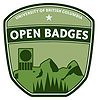Documentation:Open Badges/Learn/Who
Open Badges are used in a wide range of organizations, from museums to businesses to libraries and universities. For each organization, Open Badges may serve slightly different purposes, resulting in unique badge programs.
To see how the purpose of the badge affects the design of a badge program, imagine that a university wants to issue badges for the purpose of credentialing skills gained in the classroom. For this to work, it must be possible for the badge to be exported from the university's online learning platform to a website like LinkedIn.
Alternately, imagine a museum where the purpose of the badge program is to enliven the exploration of the museum's collection. To maximize the feel-good factor, it makes sense for such badges to be aesthetically beautiful.
Compared to universities and museums, business organizations may yet have different purposes with regards to badges. In business, badges may be used to mark milestones in the professional development of employees. For this reason, such badges may represent skills of increasing difficulty.
Of course, these are generalizations. To better understand the innovative ways badges programs are being designed, consider the following case studies.
UBC Badge Initiatives
In 2014, three programs at UBC incorporated badges into the delivery of their content:
Additional Badge Initiatives
Open Badges have been gaining traction worldwide. Such programs include:

